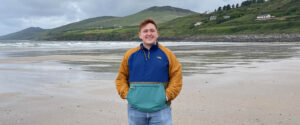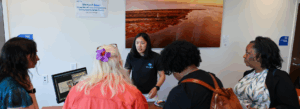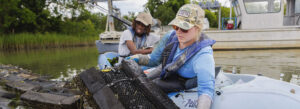Researchers know how clams respond to ocean acidification. But no studies have looked at how these stressful conditions affect their interactions with other animals like crabs.
When Katherine Longmire was watching a tank full of crabs and clams during a summer project, she noticed something odd — the crabs behaved differently in the tank with acidic conditions. It wasn’t the focus of her project, but when she became a master’s student at the Virginia Institute of Marine Science, she continued studying blue crabs and clams, and how ocean acidification affects them.
“We put one crab into a tank with a bunch of clams, and the crabs either found all of the clams and ate all of the clams, or they just sat there,” Longmire said. “But in the acidified conditions, all of the crabs found at least one clam. And then they just stopped eating.”
Fewer studies have looked at how water acidity affects crustaceans like blue crabs. Almost no research looks at how changes in water conditions affects the way these animals interact with one another.
In the Chesapeake Bay and open ocean, acidification occurs as the water absorbs carbon dioxide from the atmosphere. Most acidification research focuses on shellfish like clams and oysters, since acidic water contains less of the material that they need to build their shells.
“Crabs are a little bit different,” said Rochelle Seitz, a research professor at the Virginia Institute of Marine Science. “They incorporate a lot of other minerals into their shells, so there’s some complex interactions that happen with crab shells. It’s not as straightforward as what you see with clams.”
But acidification isn’t the only change expected in the coming decades for the Chesapeake Bay. Increases in rainfall will result in lower salinity in the Bay. Hard clams don’t grow as fast and can even die if salinity is low enough. Longmire’s study included both these factors — high acidity and low salinity — both individually, and combined together.
First, she studied how blue crabs and clams reacted to these stressful conditions individually. After keeping the crabs and clams in low salinity and high acidity, she measured whether the clam and crab shells had weakened. She found that hard clams’ shells were weakened by low acidity. Blue crabs’ shells were also slightly weaker, but the outer layer of their shell helped protect them.
While blue crab shells remained relatively strong, Longmire found that crab claws had a weaker pinch the longer they were exposed to acidic water. When she put crabs and clams in the same tank, she found the crabs exposed to acidic conditions and low salinities tended to eat fewer clams and move around less.
But if clams have weaker shells, and crabs have weaker claws, will that change how much crabs will eat hard clams? “Will the blue crab and clam relationship change? The short answer is no, based on my study,” Longmire said.
Even so, weaker clam shells and weaker crab claws might leave both these animals more vulnerable to other predators in stressful water conditions. Also, even when crabs can adapt to stressful conditions, this may leave them with less energy for other tasks, like growing and molting or reproducing.
“Both of those in combination is something animals will have to deal with in the future with climate change,” Seitz said. “Looking at both those together is really important.”
Longmire’s study included individual stressors — high acidity and low salinity — both individually, and combined together.
Takeaways:
- Hard clams’ shells were weakened by low acidity. Blue crabs’ shells were also slightly weaker, but the outer layer of their shell helped protect them.
- In stressful water conditions from higher acidity and low salinity, blue crabs tended to feed less and had weaker claw strength. Hard clams also had weaker shells.
- Even when clams and crabs can adapt to stressful conditions, they may have less energy leftover for other tasks, like eating and reproducing.
Photos by Mallory Huxford | Virginia Sea Grant
Photos and Video by Aileen Devlin | Virginia Sea GrantPublished July 2, 2021.
“Will the blue crab and clam relationship change? The short answer is no, based on my study,” Longmire said.





